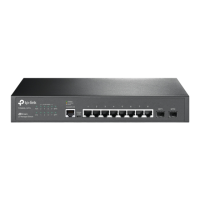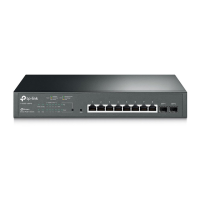20
Gigabit L2 Managed Switch
Conguration
Figure 5-3 Main Page of the Switch
5.2 Congure the Switch Using CLI
You can log on to the switch and access the CLI by the following two methods:
■
Log on to the switch by the Console (USB) port or Console (RJ-45) port on the
switch.
■
Log on to the switch remotely by a Telnet or SSH connection through an Ethernet
port.
■
Logon by a Console Port
The switch has two console ports: an RJ-45 console port and a Micro-USB console
port. Console output is active on devices connected to both console ports, but
console input is only active on one console port at a time. The Micro-USB connector
takes precedence over the RJ-45 connector.
Install the TP-Link USB Console Driver if you are using the USB serial port for the
first time on a Windows-based PC
.
The driver can be found on the attached CD and
Download page of our official website. Refer to the User Guide to learn more about
the installation.
To log on to the switch by the console port on the switch, please take the following
steps:
1. Connect the PCs or Terminals to the console port on the switch by a provided
cable. Refer to 4.3 Console Port to learn how to connect.
2. If you attach a PC, start the terminal emulation program (such as the
Hyperterminal)on the PC.
3. Specify the connection COM port in the terminal emulation program. If the Micro-
USB console port is used, you can view which COM port number is assigned to
the USB serial port in the following path: Control Panel -> Hardware and Sound ->
Device Manager -> Ports -> USB Serial Port.
4. Configure the terminal emulation program or the terminal to use the following
settings:
■
Baud rate: 38400 bps
■
Data bits: 8

